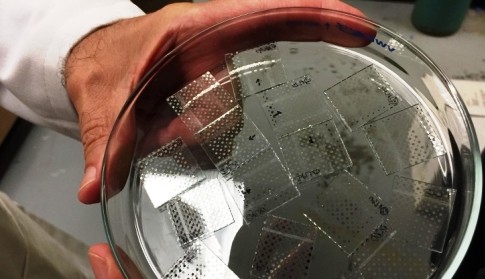Supercap energy density rivals batteries
August 05, 2015
on
on

A novel design of supercapacitor using a hybrid silica sol-gel material and self-assembled monolayers of a common fatty acid has been developed by researchers working at the Georgia Institute of Technology. The device is said to provide an electrical energy storage capacity rivaling certain batteries, with both a high energy density and high power density.
The new material is composed of a silica sol-gel thin film containing polar groups linked to the silicon atoms and a nanoscale self-assembled monolayer of an octylphosphonic acid, which provides the insulating properties. The bilayer structure blocks the injection of electrons into the sol-gel material, providing low leakage current, high breakdown strength and high energy extraction efficiency.
“Sol-gels with organic groups are well known, as are fatty acids such as phosphonic acids,” noted Joseph Perry, a professor in the School of Chemistry and Biochemistry at the Georgia Institute of Technology. “But to the best of our knowledge, this is the first time these two types of materials have been combined in a high-density energy storage device.”
In tests the new structures yielded energy densities up to 40 J/ccm, an energy extraction efficiency of 72 % with a field strength of 830 V per micron, and a power density of 520 W/ccm. This performance exceeds that of conventional electrolytic capacitors and thin-film lithium ion batteries, though it doesn’t match the lithium ion battery formats commonly used in electronic devices and vehicles. If the material can be scaled up from laboratory samples, devices made from it could surpass traditional electrolytic capacitors for applications in electromagnetic propulsion, electric vehicles and defibrillators. Capacitors are often used alongside batteries in these applications because they can provide large amounts of current quickly. Click here for more information from the press release.
The new material is composed of a silica sol-gel thin film containing polar groups linked to the silicon atoms and a nanoscale self-assembled monolayer of an octylphosphonic acid, which provides the insulating properties. The bilayer structure blocks the injection of electrons into the sol-gel material, providing low leakage current, high breakdown strength and high energy extraction efficiency.
“Sol-gels with organic groups are well known, as are fatty acids such as phosphonic acids,” noted Joseph Perry, a professor in the School of Chemistry and Biochemistry at the Georgia Institute of Technology. “But to the best of our knowledge, this is the first time these two types of materials have been combined in a high-density energy storage device.”
In tests the new structures yielded energy densities up to 40 J/ccm, an energy extraction efficiency of 72 % with a field strength of 830 V per micron, and a power density of 520 W/ccm. This performance exceeds that of conventional electrolytic capacitors and thin-film lithium ion batteries, though it doesn’t match the lithium ion battery formats commonly used in electronic devices and vehicles. If the material can be scaled up from laboratory samples, devices made from it could surpass traditional electrolytic capacitors for applications in electromagnetic propulsion, electric vehicles and defibrillators. Capacitors are often used alongside batteries in these applications because they can provide large amounts of current quickly. Click here for more information from the press release.
Read full article
Hide full article


Discussion (0 comments)